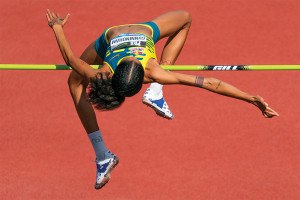How Womanly Does a Woman Olympic Athlete Have to Be?
The women competing in the U.S. Olympic track and field trials have been outrunning a lot over the past couple of weeks. Stiff competition, injuries. Julia Lucas, who has had seven stress fractures throughout her career, lost her ticket to London the last few steps of the 5K. Allyson Felix and Jeneba Tarmoh locked times in the 100-meter race for a dead heat. Like only the pros can, these runners have cleared hurdles with the kind of superhuman power that inspires jogging mortals like myself to keep blending those morning smoothies.
I have a nerdy enthusiasm for this sport. The underdog stories and neck-and-neck final laps get under my skin—which is why I’m refusing to get too downtrodden about the cloud the International Olympic Committee has just blown over the world of women’s sports.
Just a few weeks ago, the organizing Olympic body issued a new set of sanctions to “regulate standard procedures in the investigation and follow-up of a possible case of female hyperandrogenism.” Women with androgen—that is, testosterone—levels “in the male range” (no word yet on what the hell that exactly means) are a threat to Olympic integrity, they say. They may (emphasis on the “may,” since there’s currently no evidence that testosterone levels alone would result in automatic super-speed) have an unfair advantage, and should be handled the same way dopers or other cheaters are: with disqualification.
Proponents of the new measure, like UCLA geneticist Eric Vilain, say that the new testing will “in times of instant fame and wealth in sports,” protect against men trying to compete as women. Indeed, most of the men I know envy the Bentleys and Blahniks that female track and field athletes are famed to enjoy.
The perceived need for such a regulation was spurred by Caster Semenya, a world champion 800-meter runner from South Africa whose 2009 gold medal at the Berlin World Track and Field championships was called into question because of—well, her appearance. Semenya is what the New York Times called a “muscular, husky-voiced” woman, just 18 years old when she was forced to undergo an invasive biological sex investigation to prove her womanhood. (And I don’t drop the word “invasive” casually. The IOC’s medical commission’s chairman, Arne Ljungqvist, an 81-year-old white European sports official, has promised that a psychologist would be available to any woman subjected to the procedure. If that isn’t an official acknowledgment of how humiliating, if not traumatic, the now-sanctified testing could and would be, I’m not sure what is.)
Almost two years later, the International Association of Athletics Federations has declared Semenya biologically ladylike enough, and she’s headed to London in a couple weeks. Despite her more masculine attributes, she may not wind up a gold medalist. Many debates over the extent to which testosterone results in faster time, or the significance of testosterone levels in determining sex have yielded little. Talent, like gender, is an epistemological question, determined by physiological and social factors unknowable and variable. And for all the haranguing Semenya would probably face if she were to win the Olympic race fair and sex-squared away, a comfortable top-five finish might prove easier for everyone.
And that’s always the case, isn’t it? It’s always just easier for everyone when female athletes look and perform as we expect and are prepared for. It’s easier to set the course for them, and call foul when someone veers. It’s easier to set guidelines and parameters for women that have no conceivable parallel in male sports, because even today, in 2012, we cannot shake our need to compartmentalize women in sports.
In fact, since I mentioned the International Association of Athletics Federations a moment ago—that wordy, stuffy organization that oversaw Semenya’s testing—a bit more on them: Last fall, they instituted a policy effectively saying that any national or world records held by female runners would only be considered valid if they had been run in women’s-only races. If they had been run alongside men (say, oh, Paula Radcliffe’s two-hour-and-15-minute marathon in London), the pacing was considered an unfair advantage. Disqualified. (After a tornado of outrage, the IAAF later “allowed” Radcliffe’s record to stand).
I don’t exactly know why the IOC or the IAAF presume that female runners want to jog down Easy Street toward the finish line; why for every scrap thrown to women’s athletics over the years, we must shave a thin layer off those successes. And why for all the strides we have taken forward—I count the miles in my own measly training log toward this fund—we need to unravel another strand of feminist sensibility.
It’s doubtful whether or not this new sex-testing rule would even being utilized during the London Games. But with it on the books, with yet another caveat and condition women must read and sign at the Olympic gates, we undermine the barrier-pushing that has made our sport. All because of the hypothetical that a man might try to compete as a woman for a shot at gold in some lunatic Mrs. Doubtfire ploy. The answer, people, is plain. It’s not worth it. To tell women—and thus to imply to girls—that they cannot be a certain kind of confusing, not-in-the-rulebook female to be considered a female athlete, is an unjustifiable blow to the field.
Of course, the runners won’t wallow in this. There’s still exciting races to be watched this summer. In fact, I’ll probably watch more of them this time around, and maybe even log a few more runs myself. Turns out, we all still have a lot to outrun.


